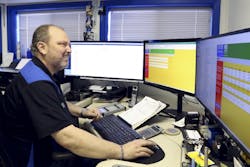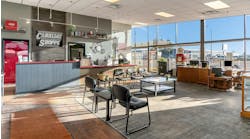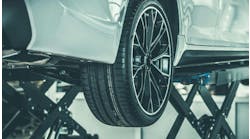SHOP STATS: Lake Mac Auto Body Location: Ogallala, Neb. Size: 18,000 square feet Staff: 6 Average monthly car count: 43 Annual revenue: $1.7 million (Projection for 2017)
For years, Kevin Lockhart steadily built his empire. His company, Prophet Systems Innovations, became a leading supplier of software and hardware for radio stations. He directed his team to handle rapid growth from less than $1 million in sales in 1997 to over $32 million by 2001, and his workforce grew from 11 people to 146 people in that time. It was a challenging market in which Lockhart’s company eventually became the worldwide leader.
And, to him, none of that compares to running a collision repair shop.
“Running a local body shop is harder than running a worldwide computer company,” Lockhart says with a laugh. “I absolutely got my head handed to me for the first few years. There’s a lot of complexity to a body shop I had no idea.”
Back in 2010, when Lockhart purchased a foreclosed building with his wife, Elise, in Ogallala, Neb., and turned it into Lake Mac Auto Body, the company’s slow start was evident from its low technician efficiency (it was just under 77 percent) and net profit (which was in the red).
And the most telling number: Touch time sat at 2.3 hours.
Perhaps the most underutilized and telling KPI in the industry, Lockhart says, touch time (the average number of hours per day a vehicle is touched by technicians) is a true indicator of productivity and profitability in the shop—the more hours worked on each vehicle each day, the higher the efficiency, the quicker vehicles can return to customers.
Switching to a team system and focusing on fewer vehicles (as advised by his paint company) one year ago raised the shop’s average touch time to 6.5 hours. That, Lockhart says, brought up all those other numbers (efficiency is at 190 percent and net profit hit 22 percent in January) and has now set the shop up for growth.
Problem/Solution: Finding the Team Mindset
The Lake Mac staff looked much different just one year ago.
“Before, we basically had five people doing what two should have been doing,” Lockhart says.
As profits continued to hang around zero percent, that fact became increasingly obvious. The shop had a very “individual-based” culture, in which technicians were constantly guarding their assigned jobs.
“They had their bowl of food, and they crouched over that, eyeing each other, saying, ‘Don’t touch my jobs,’” Lockhart recalls. “But to be efficient, you need teamwork, you need techs helping techs.”
Lockhart lays it out with an example: Say two techs are assigned four vehicles apiece. Each of them, in theory, would split time between each vehicle, averaging two hours of touch time per day.
But what if two technicians shared four cars? By focusing on moving less vehicles along more quickly, touch time would automatically double to 4 hours. When the vehicle finishes, you have charged the same amount of hours in less time, increasing both efficiency and profitability.
When Lockhart realized this, he knew he needed to establish a team system and improve touch time.
The Implementation: Getting on the Same Page
Lockhart’s own ignorance regarding KPIs had transmitted directly to his team. The technicians did not understand why closely guarding their jobs was inherently causing low efficiency numbers. Lockhart started to preach important KPIs at his meetings—specifically touch time.
“In the beginning, we would have staff meetings weekly where we would discuss the things affecting efficiency and touch time,” he says. “As I was doing that, it became clear who was listening and who was not.”
Lockhart’s top technician is 65 years old and a prime example of a productive employee. He rarely brings his cell phone out, doesn’t goof around, and keeps conversations to a minimum.
The same could not be said for Lockhart’s other technicians one year ago.
“It’s one of the harder things to get through to the younger guys,” Lockhart says. “It might just seem like two minutes to check a text, but when you disengage from what you’re working on, check your text, and then have to re-engage—if you’re doing that every time your phone dings, it affects touch time.”
The Incentive
On a salary pay system with no incentives, everyone besides Lockhart’s top technician was churning out dismal numbers, which ultimately kept the shop’s profits in the red.
The behavior had caused the shop’s profits to reach a breaking point, so Lockhart placed strict requirements on hitting 120 percent efficiency. This weeded out three people, leaving two technicians (one split time between body and paint) who were motivated to hit benchmarks.
Lockhart then incentivized working on jobs as a team, as opposed to individually. Payroll changed from hourly to flat rate, and employees could earn an extra $100 on their paychecks for every hour of touch time they achieved.
“It made a huge improvement in morale and efficiency,” Lockhart says. “They were making more money, and got used to the idea that if they helped each other increase touch time, they could keep making more and more.”
Continuous Improvement
As his team got addicted to improving touch time, meetings turned into brainstorm sessions on improving KPIs.
This involved studying layout and throughput, eliminating any waste or unnecessary movement. For body work, this meant investing in parts carts that kept tools nearby at all times. For paint, it meant upgrading to more durable equipment that allowed his painter to work consistently on each job.
On top of that, Lockhart found ways of motivating employees to keep touch time in mind during the smallest of moments.
“If it’s five o’clock and you have 15 minutes left on a job, stay and finish, because 15 minutes will turn into an hour the next morning because you have to re-engage,” Lockhart says. “I started becoming more lenient: If they stayed an extra 15 minutes, I’d let them take time off during slow times.”
“We have individual weeks where body is running at 250 percent and paint tops out at 175."
—Kevin Lockhart, Owner, Lake Mac Auto Body
The Results
Touch time now averages at 6.5 hours per day (some weeks it hits an average of 7.5, Lockhart says), leading the way for 190 percent efficiency in body, 165 percent in paint, and a 22 percent net profit margin overall. With just two technicians, Lake Mac’s two techs have matched the annual revenue formerly achieved by five technicians.
With the new pay plan and incentives in place, his top technician, during his best weeks, turns in 95 hours of work without overtime. His two techs once managed to churn out $130,000 of work in a single month. In February, Lockhart added a third, full-time painter to the team.
“We have individual weeks where body is running at 250 percent, and paint tops out at 175,” Lockhart says.
With less employees, Lockhart felt more comfortable turning away “junk work,” raising the average ticket price from $1,300 to $3,130 in 2016.
“When we were capacity limited during the last four months when we were down to just two senior techs, this made a huge difference,” he says. “We were still able to keep our sales level even with less capacity.
“The techs love it too. They don’t have to work on junk anymore and they make a lot more money with less hours worked.”



